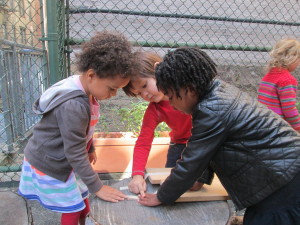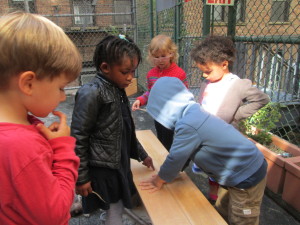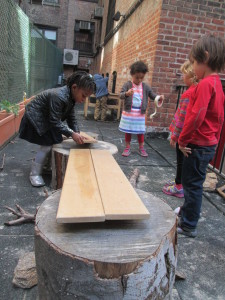Welcome Back Remarks
My opening remarks from our Annual Welcome Back meeting for all parents, faculty and staff:
The beginning of the school year is always filled with much anticipation. What will my child learn at Greenhouse? How will the curriculum goals be implemented? Will my child be ready for kindergarten?
There is much debate these days about how early educators can best support young children’s cognitive development. Political interest and educational standards are pressuring some schools to rethink their practices; schools are moving away from play and exploration in favor of formal, teacher-led instruction. Despite the fact that there is little research evidence that direct instruction at an early age has any positive effect on children’s long-term academic achievement. Current research, in fact suggests that formal instruction too soon might be doing the exact opposite; it may be weakening children’s natural intellectual disposition. 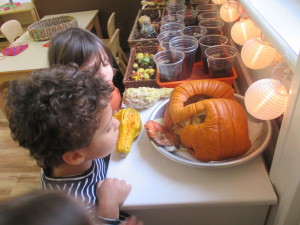
At Greenhouse, we understand how the power of discovery and the power of play join together to create the perfect conditions for both academic and intellectual learning in our young children. We strive to support the ‘life of the mind in its fullest sense’ (Katz, 2015); we help our children find meaning in their world. We believe the heart of early childhood education is growing children’s innate intellectual disposition and providing a wide range of opportunities for meaning making.
We begin deep inside a child’s intellect; deep inside her curiosity, her questions, her wonder—“Why is one pumpkin rotting and the other not?” We foster what Eleanor Duckworth (2006) calls the “having of a wonderful idea.” We believe that the essence of intelligence lies within thinking and the having of ideas not within the reciting of facts and giving of correct answers. Over and over again, we want our child to experience that moment when an idea actually forms inside their own mind. The impact of feeling an idea form inside your brain (instead of simply being told or instructed what to think, what to know or shown what to do!) is quite significant. When a child possesses an idea, when he feels self-motivated to act on that idea, then that child owns both the process of learning and the new information discovered.
In that moment, we’ve taught him how to learn, how to be an active pursuer of information! In contrast, when we tell a child the correct answers, when we tell her what to do, what to say, then we’ve taught her that the adults are the keepers of knowledge, adults are the knowers of all the answers, adults are in charge of learning. Then children have learned how to be taught and how to passively wait to be instructed.
Instead, at Greenhouse, we support a child’s innate passion to make sense of their world. Young children are natural explorers. Research confirms what many of us parents already suspected–an average preschooler asks 100 questions a day; our children thirst for understanding and meaning. They are naturally curious and have deep, internal intellectual lives. Instead of stifling that with facts, right answers, rules and regiment, we want to join them in their quest for meaning. In doing so, we are encouraging children to develop the habits of the mind that will foster a life-long curiosity and love of learning. When we value a child’s thinking and join them on their journey of discovery we are helping them to actively move towards a deeper meaning of the world.
While we are nurturing our child’s intellectual dispositions, we are also encouraging and motivating our children to practice content skills. We can do both. It is not a case of one or the other–play-based or instruction. Our children practice academic skills in the service of their intellectual pursuits (Katz, 2015). Instead of isolating skill learning into discrete, small segments at specific, adult-assigned times, we practice skills like letter names and letter/sound correspondence in a meaningful context like when we are making signs in our dramatic play. We practice skills like visual discrimination and identification when we match like colored magna tiles to make boxes. Skills and concepts about number —like more/less and most are learned in an integrated, concrete way. When you set out to answer the question, “how tall are our flowers?” 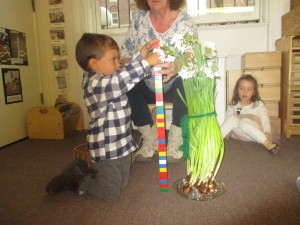 And you use the Duplos as a non-standard measuring tool, you are practicing measurement skills as well as counting and quantity. All in the context of answering a very relevant question! When we practice our skills, it is always to make meaning. It is always in the service of our intellectual pursuits.
And you use the Duplos as a non-standard measuring tool, you are practicing measurement skills as well as counting and quantity. All in the context of answering a very relevant question! When we practice our skills, it is always to make meaning. It is always in the service of our intellectual pursuits.
Play becomes the vehicle through which our children’s lively minds manifest themselves in the world. When we watch children play, we are watching them think. When we watch children play, we are watching them express their knowledge. The teacher’s job is to watch the play and figure out what is just the right material or question that will move a child’s thinking or skill level forward. Sometimes a child is leading their own play—for example, when a child finds an interesting material and she decides to sort and organize the material by color, she is showing us what she knows about color, sorting and grouping. Sometimes a child and a teacher are co-constructing the learning together. An adult joins in the play as a co-constructor of knowledge–we call this scaffolding or guided play. An adult might drop an important questions like “What do you think would happen if we tried a different ball? Or a bigger straw?”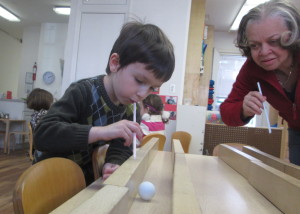 In these moments of play, a teacher is right there, along-side the children, thinking together, and learning together. There are also times when a teacher is leading the exploration, and utilizing direct instruction; she might introduce the concept of counting by 10s as the children count how many stick bugs are in your tank. Whichever strategy we employ, child-led, co-constructed or adult-led, we see play as the primary way of helping children develop and express their thoughts.
In these moments of play, a teacher is right there, along-side the children, thinking together, and learning together. There are also times when a teacher is leading the exploration, and utilizing direct instruction; she might introduce the concept of counting by 10s as the children count how many stick bugs are in your tank. Whichever strategy we employ, child-led, co-constructed or adult-led, we see play as the primary way of helping children develop and express their thoughts.
There is deep intellectual and academic learning found within play. There are also a host of other valuable and necessary opportunities for learning found in play, like the opportunity to develop self -regulation, social competence and problem-solving abilities as they interact with materials and peers. As friends enter into creative work alongside each other, the materials inspire them to express their thoughts and share their ideas. Group projects help children practice how to share a common goal and work side-by-side with a peer to reach that goal. There are always problems to solve and ideas to listen to when working with a friend. Play provides the perfect opportunity to do just that! It also promotes language development and symbolic thinking. When our children pretend, they are showing us that they have the mental ability to see an object as a symbol for something real. We call this symbolic thinking and is an important skill to practice. It is what eventually allows your child to know that those black and white scribbles on a page are actually words that hold meaning! Executive functioning skills like planning, organizing, and focusing are inherently developed in play. Loose parts—or open-ended materials—encourage these executive functioning skills. Our play-based environment provides the very foundation for our work.
On top of that foundation, we then build a project or investigations based on the interest of our children—in other words—our projects are based on their intellectual pursuits. As the kids go about their work, we watch and listen and inevitably something of interest bubbles up! According to Duckworth (2006), intelligence and learning cannot be developed without something to think about. We know we found the right topic when we see that there are many different ways to enter into or think about the topic. We know we found the right topic when we get excited and we feel a deep yearning to know why? Or what? Or how? Our topics must be complex and not oversimplified. We do not set out with preconceived answers or expectations; together, we are excitedly exploring the unknown! We respond to interesting things as they happen to us and this leads us to other engaging and stimulating activities and ideas. Through it all, we talk and discuss and share our ideas with our peers and our teachers. Since our kids are so experienced at having ideas, we provide lots of opportunity and practice to move those thoughts from their heads, into their words and into action! We want them to know in their bones that what they think (and not just what they know!) matters to us. We want them to speak their minds freely and never censor themselves because they are not sure they have the right answer. We want them to eagerly take a risk and share their ideas and not sit and wait for others to contribute. We want them to know they have worthwhile contributions and that they should never worry that their input might not be valuable. That means we welcome disagreements and varying ideas! It takes a very mature listener to take in another’s idea and to realize and respect that you friend has a different point of view.
Ultimately, we want our kids to know that a good question is often times more valuable than a right answer. A good question like—How can we build a bridge? What materials do we need to make it sturdy? How do we work together to see our goal through? Will the bridge be sturdier if we add another slat to make it wider?
With every new idea, we find a new obstacle. Solving problems and finding answers requires us to look at things from many different angles and see many different solutions and answers. Yes, we as the adults in this world might think we know the ‘right’ way to build a bridge between two logs. We could have instructed, guided or directed them on how to do it. Or we can encourage this. 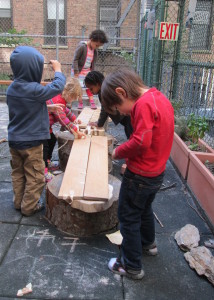 We can set up the environment with rich materials and let the wonderful ideas form inside our children’s brains. Then the children own both the bridge itself and they own the very idea of the bridge. These skills—collaboration, the having of wonderful ideas, asking good questions, divergent thinking– these are the skills that will make our kids successful in school and beyond as they set out to solve 21st century problems.
We can set up the environment with rich materials and let the wonderful ideas form inside our children’s brains. Then the children own both the bridge itself and they own the very idea of the bridge. These skills—collaboration, the having of wonderful ideas, asking good questions, divergent thinking– these are the skills that will make our kids successful in school and beyond as they set out to solve 21st century problems.
At Greenhouse, we know it is our joyful responsibility to incite our children’s passion and drive to grow and nurture the full life of their mind. We know that direct instruction alone will fail to create learners that can discover answers to new, untold questions and find the innovative solutions to problems yet unknown. If we want adults that can create original solutions and ideas in the future, we know we need to set the groundwork for them to play, practice and own their ideas in their childhood.
So to those that wonder, “Will my child be ready for kindergarten?”…I answer with a responding “Yes! Your child will be ready for kindergarten and for a life-long journey of learning!”
Best wishes for a wonderful year of learning,
Renee
Reference
Duckworth, E. (2006). The having of wonderful ideas and other essays on teaching and learning. NY: Teachers College Press.
Katz, L., (2015). Lively minds. Defending the Early Years
